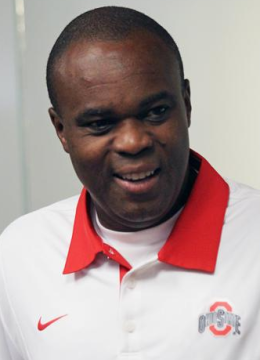It will be hard to measure how much Urban Meyer altered the fate of the 2012 Ohio State football team with the performance evaluations he administered to OSU assistant coaches last June. There’s every chance that Meyer’s criticism in those evaluations played a role in the Buckeyes’s 12-0 season, and perhaps even greater accomplishments in seasons to come.
The performance evaluations were obtained by The Lantern through a public records request and list the positive attributes of each coach as well as areas for improvement. Some evaluations appear less thorough than others (there was nothing listed in the “work on” section of offensive coordinator and quarterbacks coach Tom Herman’s evaluation) and some are vague and hard to decipher. The prevailing theme was that Meyer, whose criticism ranged from recruiting tactics to making more efficient use of the team’s time on the practice field, wanted improvement from the OSU assistants.
The program’s assistants completed a self-evaluation before Meyer met with them to verbally provide his evaluation, according to a university human resources statement provided by OSU athletics spokesman Dan Wallenberg. Brief summaries of Meyer’s comments were typed on the evaluation documents, and according to the text, they were completed on June 25 and 26.
Zach Smith: Wide receivers coach
Meyer encouraged each OSU coach to improve on the recruiting trail, but the Buckeyes’ then-first-year receivers coach Zach Smith appeared to be a weakest link on OSU’s powerhouse staff of recruiters.
According to the evaluation documents, Meyer wrote that Smith “needed improvement” with regard to recruiting, adding that he needed to work on being “thorough and intense.”
Meyer also said that Smith needed to improve his on-field energy as well as his ability to complete tasks efficiently, according to the documents.
Smith was more critical of himself in his self-evaluation than his peers on the OSU staff.
Coaches graded themselves on a five-point scale in various categories and Smith was the only coach to give himself a grade lower than “3,” according to the documents. Smith gave himself a “2” regarding “Coaching what he sees on tape” and “Productivity in recruiting,” noting that he “need(s) to be aggressive with (wide receivers) and have conviction on area recruits — improve time management.”
Tim Hinton: Tight ends, fullbacks coach
Demands for “competitive excellence” and aggressive recruiting were common, but Meyer reserved what might have been his harshest criticism for Tim Hinton.
Meyer said that Hinton’s top priority should be working on his “ability to articulate the offense” better, according to the evaluation. Additionally, Meyer wrote that Hinton needed to work on the “efficiency of practice time.”
Mike Vrabel: Defensive line coach
Meyer told Vrabel to take a wins-and-losses approach to the recruiting aspect of his job, writing, “Same approach to recruiting as playing (No excuses, W/L).”
Meyer also appeared to encourage Vrabel — a three-time Super Bowl champion with the New England Patriots — to work on using his professional experience to better develop the team’s defensive line.
Everett Withers: Associate head coach, co-defensive coordinator, safeties coach
Much of Meyer’s criticism for Everett Withers was related to recruiting. On the evaluation, Meyer wrote “1.) Close on a difference maker. 2.) Intensity and thoroughness in recruiting.” A third criticism – “competitive excellence of players in off-season” – was also levied.
Ed Warinner: Co-offensive coordinator, offensive line coach
Meyer’s No. 1 criticism of Warinner was, presumably, that he wasn’t building strong relationships on the recruiting trail. All Meyer wrote on this matter was “Relationships in recruiting.” The second item listed was closing on offensive line recruits, followed by “engagement.”
Meyer’s elaboration regarding the latter only went as far as to say “family, non-football discussion.”
Kerry Coombs: Cornerbacks coach and special teams coordinator
Meyer encouraged the fiery Coombs to work on closing on a big-time recruit and production of his cornerbacks unit for fall. Coombs responded to Meyer’s recommendations by helping then-sophomore cornerback Bradley Roby achieve first-team All-American honors (ESPN) after a 2012 season in which he caught a team-high five interceptions. Roby was also a Thorpe Award semifinalist.
Stan Drayton: Running backs coach
In addition to encouraging Drayton to up his game on the recruiting front, it appears that Meyer wanted his running backs coach to provide fresh ideas to game plans for the running backs.
“Get a big timer: recruiting,” Meyer wrote as the top item on Drayton’s evaluation. Like other OSU assistants, Meyer also said he wanted Drayton to get competitive excellence out of the running backs.
Lastly, Meyer wrote, “Creativity/ideas in game planning.”
Luke Fickell: Co-defensive coordinator, linebackers coach
For Fickell, whose one-season tenure as OSU head coach was sandwiched between the exit of former Buckeyes coach Jim Tressel and the arrival of Meyer, the first item of business was establishing himself as a leader on Meyer’s coaching staff. “Leadership role on staff,” wrote Meyer, who also listed Fickell’s ability to adapt and embrace his fellow staff-members as a positive.
Fickell was the only coach that opted to leave a remark in the “employee’s comments” section of the evaluation, writing, “Great meeting with lots of constructive suggestions to get better.”
Wallenberg declined to make any of the football coaches available for comment, saying that, generally, the department does not comment on personnel issues. So, while the extent to which coaches made improvements after their performance evaluations were administered remains to be seen, it could be safely assumed that at least a couple of Meyer’s criticisms related to on-field issues were addressed and corrected in time for the team’s undefeated, Big Ten Leaders Division championship season.
Some of Meyer’s concerns regarding recruiting tactics were likely addressed as well and improved the Buckeyes’ 2013 recruiting class ranked No. 2 in America, according to Rivals.com.
Again eligible for postseason competition after serving a one-year ban after the undefeated 2012 season, OSU will begin the 2013 season with an Aug. 31 game in Columbus against Buffalo.



